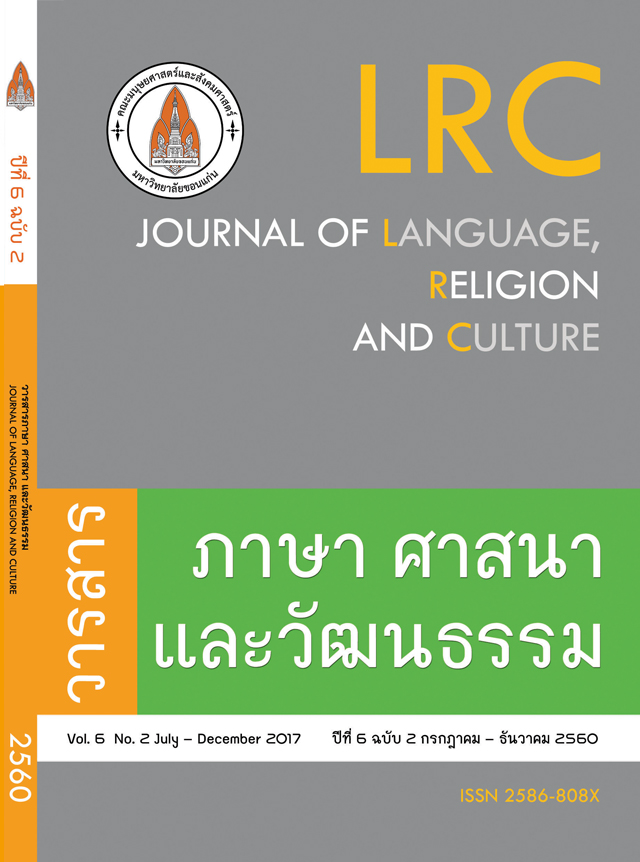เสียงวรรณยุกต์ในภาษาไทยสมัยรัชกาลที่ 5 และปัจจุบัน; Thai Tones in the Reign of King Rama V and Now
คำสำคัญ:
วรรณยุกต์ภาษาไทย, วรรณยุกต์ภาษาไทยสมัยรัชกาลที่ 5, Thai tones, Thai tones in the reign of King Rama Vบทคัดย่อ
งานวิจัยนี้มีวัตถุประสงค์เพื่อศึกษาสัทลักษณะของเสียงวรรณยุกต์ในภาษาไทยสมัยรัชกาลที่ 5 และเปรียบเทียบสัทลักษณะของเสียงวรรณยุกต์ในภาษาไทยสมัยรัชกาลที่ 5 กับสัทลักษณะของเสียงวรรณยุกต์ภาษาไทยในปัจจุบัน โดยเสียงที่บันทึกในสมัยรัชกาลที่ 5 ได้จากแผ่นเสียงที่มีการบันทึกไว้แล้ว นำมาคัดเลือกคำศัพท์และเปรียบเทียบกับเสียงวรรณยุกต์ภาษาไทยในปัจจุบันด้วยคำศัพท์ชุดเดียวกันที่คัดเลือกจากแผ่นเสียง
ผลการวิจัยพบว่าเสียงวรรณยุกต์ภาษาไทยในสมัยรัชกาลที่ 5 มีสัทลักษณะของเสียงวรรณยุกต์สามัญเป็นวรรณยุกต์กลาง-ระดับ วรรณยุกต์เอกเป็นวรรณยุกต์ต่ำ-ระดับ วรรณยุกต์โทเป็นวรรณยุกต์กลาง-ตก วรรณยุกต์ตรีเป็นวรรณยุกต์สูง-ระดับ และวรรณยุกต์จัตวาเป็นวรรณยุกต์ต่ำ-ขึ้น ซึ่งเมื่อนำมาเปรียบเทียบกับเสียงวรรณยุกต์ภาษาไทยในปัจจุบันพบว่า สัทลักษณะของวรรณยุกต์โทมีการเปลี่ยนแปลงจากวรรณยุกต์กลาง-ตก เป็นวรรณยุกต์สูง-ตก และวรรณยุกต์ตรีเปลี่ยนจากวรรณยุกต์สูง-ระดับเป็นวรรณยุกต์กลาง-ขึ้น
Abstract
The purpose of this study is to investigate the phonetic characteristics of Thai tones in the reign of King Rama V and to compare the phonetic characteristics of Thai tones in the reign of King Rama V with the phonetic characteristics of Thai tones at the present time. An audio recording of the speech from the reign of King Rama V is collected from a gramophone record, and word list is selected from this audio record. Then, we compare the phonetic characteristics of Thai tones in 2 periods by using the same word list selected from an audio record.
The results show that the characteristics of Thai tones in the reign of King Rama V are mid-level (mid tone), low-level (low tone), mid-falling (falling tone), high-level (high tone), and low-rising (rising tone). Comparing with Thai tones nowadays, it is found that falling tone and high tone have changed: falling tone is changed from mid-falling to high-falling, and high tone is changed from high-level to mid-rising.
เอกสารอ้างอิง
พิพิธภัณฑ์ ธงชาติไทย. (23 กันยายน 2552). เสียงคนไทยที่เก่าที่สุดในโลก [คลิปวิดีโอ]. สืบค้นจาก https://www.youtube.com/watch?v=ai1pqsPpTlY
วิไลลักษณ์ จูวราหะวงศ์. (2543). วรรณยุกต์ภาษาไทยกรุงเทพฯ ที่พูดโดยคนไทย คนแต้จิ๋ว และคนซิกซ์. วิทยานิพนธ์อักษรศาสตรมหาบัณฑิต, สาขาวิชาภาษาศาสตร์ คณะอักษรศาสตร์ จุฬาลงกรณ์มหาวิทยาลัย.
ผณินทรา ธีรานนท์. (2543). หน่วยจังหวะกับการแปรของวรรณยุกต์ในคำพูดต่อเนื่องภาษาไทย. วิทยานิพนธ์อักษรศาสตรมหาบัณฑิต, สาขาวิชาภาษาศาสตร์ คณะอักษรศาสตร์ จุฬาลงกรณ์มหาวิทยาลัย.
ผณินทรา ธีรานนท์. (2545). เสียงวรรณยุกต์ภาษาไทยในสมัยรัชกาลที่ 6 และรัชกาลที่ 9. ภาษาและภาษาศาสตร์, 21(1), 33-46.
ศุจิณัฐ จิตวิริยนนท์. (2555). การปรับค่าความถี่มูลฐานโดยการแปลงค่าเฮิรตซ์เป็นเซมิโทน: แนวทางในการเสนอผลการวิเคราะห์วรรณยุกต์. The Journal: Journal of the Faculty of Arts, 8(2), 19-46.
Abramson, A. S. (1962). The vowels and tones of Standard Thai: Acoustical measurements and experiments. International Journal of American Linguistics, 28(2):1–146.
Anivan, S. (1988). Evolution of Bangkok tones. International Symposium on Language and Linguistics,8-21.
Bradley, C. B. (1911). Graphic analysis of the tone-accents of the Siamese language (with one plate). Journal of the American Oriental Society, 31(3):282–89.
Erickson, D. (1974). Fundamental Frequency Contours of the Thai Tones of Standard Thai. Pasaa, 4(1), 1–25.
Teeranon, P,,and Rungrojsuwan, R. (2009). The change of Standard Thai high tone: An acoustic study and a perceptual experiment. SKASE Journal of Theoretical Linguistics, 4(3).
Tingsabadh, M.R., and Daranee K. (1996). Tones in Standard Thai connected speech. Paper presented at the Fourth International Symposium on Language and Linguistics: Pan-Asiatic Linguistics.Bangkok, Thailand. January 8–10, 1996.
Thepboriruk, K. (2009). Bangkok Thai Tones Revisited. Working Papers in Linguistics: University of Hawaii at Manoa, 40(5).







